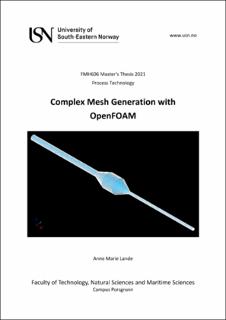| dc.description.abstract | In the course Computational Fluid Dynamics at the University of South-Eastern Norway there have been some requests for more advanced geometry and meshing tools than the lectured blockMesh dictionary and meshing tool in the open-source software OpenFOAM.
In this report, theory concerning mesh quality parameters and turbulence modeling is presented and an evaluation of different open-source meshing tools is made. Salome is evaluated to be the most user-friendly tool and is used to create and mesh a 3D model of a diverging converging pipe with belly section. 3 meshes with a hexahedral OH-grid and different wall treatments are constructed and imported to OpenFOAM. 4 different simulations are run with the steady-state turbulent incompressible flow solver simpleFoam, applying the turbulence models standard k-epsilon or k-omega SST to model the air flowing through the pipe. A student tutorial describing the workflow of one of the cases is made.
An evaluation of basic fluid mechanics checkpoints, symmetry and residuals did not indicate numerical errors in the solutions. The simulation cases generally obtained results that agreed well with the analytical solutions, even though the complex flow field of turbulent, transitional and laminar flow was modeled with turbulence models. The adjusted wall functions gave slightly better results than the default wall functions for the k-epsilon model. The k-epsilon model on Mesh B obtained pressure results that agreed well with the analytical solution. The k-omega SST model generally predicted the velocity field best, and also showed consistent results in terms of pressure loss. Case A did not fulfill the wall function requirements and obtained diverging pressure loss results. The OH-grid topology was evaluated to give good mesh optimality for the full resolution approach and insufficient mesh optimality for the wall function approach. | |
